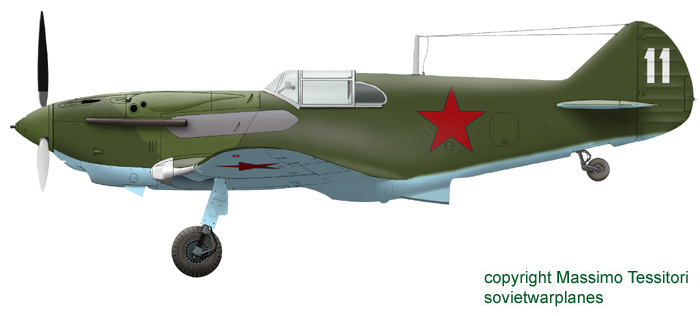Zavod 21
Plant n.21 in Gorky was the chief facility for the production of the LaGG-3.
The first plane took off on 23 January 1941, and was transferred to NII VVS where it replaced the second I-301 in the test program. Test revealed a lot of heavy defects, particularly relative to the overheating of the engine.
Around February, some LaGG-3s were delivered to 24 IAP at Liubertsy near Moscow for the operative conversion; the planes revealed problems to both the main landing gear and the rear retractable tail wheel, that tended to collapse.
s/n 31211xx
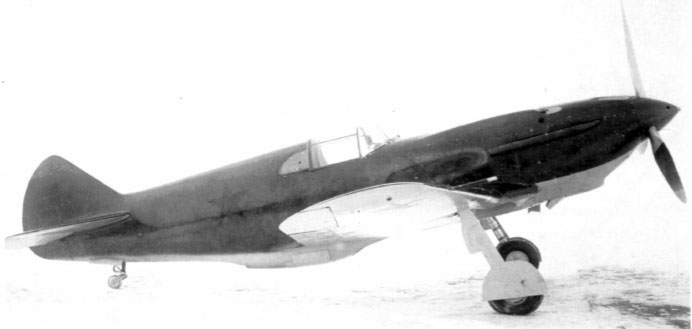
Photo of a LaGG-3 series 1 built in Zavod 21 in Gorky in early spring 1941, photographed on the airport of the factory.
We can see:
- the lack of any radio mast;
- the small, retractable, rubberized tail wheel, as those of prototypes;
- the clean profile of the lower rear fuselage, without the marked recess at the outlet of the cooler typical of most early LaGG-3s;
- the unpainted prop blades with rear part partially painted black;;
- the 5-guns configuration: three ShKAS and two UB (one synchronized and one in the prop's hub);
- the small size of the red stars, probably with black outline, that were located conformal to prewar standard.
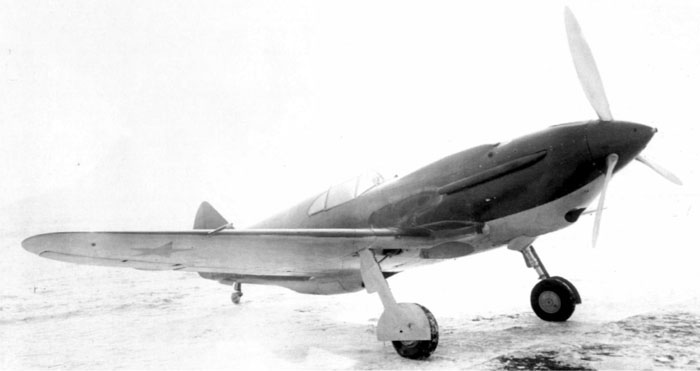
The painting of this plane is a bit mysterious; apparently it looks a typical prewar style painting, with upper and side surfaces in glossy AII green and undersurfaces in glossy AII light blue.
Looking carefully, one can see some variations in shade that look consistent between the photos, suggesting that it could have some experimental camouflage, scarcely noticeable because of the reflections and of the exposure of the photo on the snowy background.
This could also be due to a bad painting work with retouches, though, or reflections of unclear origin. The snow on the background suggests that the photo was taken much before the order of May 1941 about camouflaging planes.
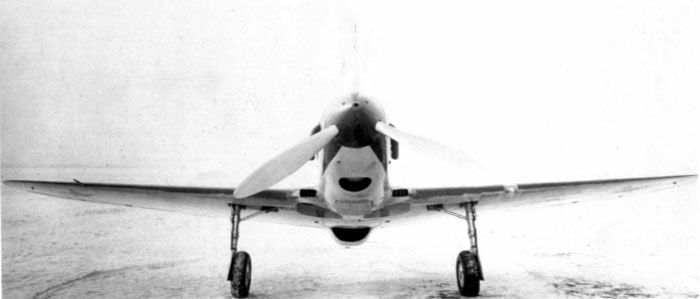
A front photo allows to see the rectangular shape of the early intakes of the supercharger. Some details of the wheel bays can be seen; the bays seem
painted in the same color of the undersurfaces.
All three photos are from Wydawnictwo Militaria 249 - LaGG-3
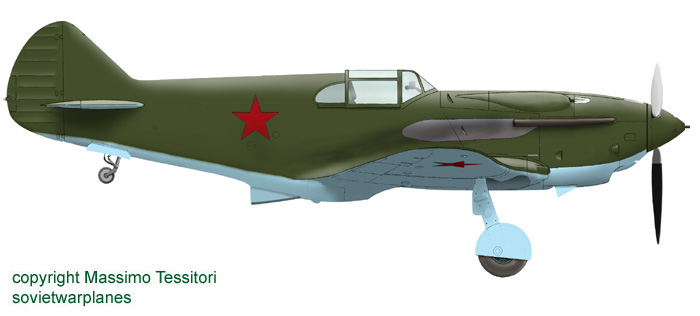
s/n 3121376
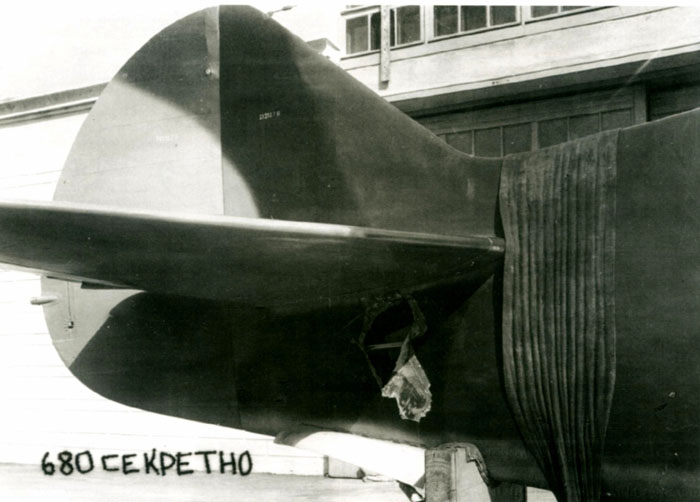
In May 1941, an order about the camouflage of Soviet military planes was published. The painting schemes, described by sketches, were complex and gave difficulties in implementation to factories and units.
According to the text of Vaklamov and Orlov, "In early June 1941
in factory number 21 in Gorky, in pursuance of an order for fighter planes,
the LaGG-3 started to have a multi-camouflage. According to Chebotarevsky,
who took part in these works, the applied color consisted of sand, brown,
grey, green and black. The used nitrocellulose paints were semi-glossy.
The shape and location of bands was determined by sketches, executed in
two or three options. In this way, 28 airplanes were painted. Among them
was LaGG-3 number 3121376, issued June 10, 1941 to June 14, which crashed
during a tests at maximum speed.
Camouflage was effective even at close distances. Despite this, the remaining
27 machines still not delivered to the Air Force, were repainted according
to the new NKAP order number 547 from June 20, 1941. Instead of multi-color
painting, they were painted in the standard two-color (black and green)
camouflage.
On the photo, we see the tail of plane s/n 3121376, n.76 of series 3 of Z.21. The photo shows a camouflage with at least 3 colors.
Other photos of the rear part do exist, showing the size and position of red stars with black outline on the fuselage and the damages to the fuselage.
Photos seem to show non homogeneous colors, with evident repaintings. It is not clear if they were simple retouches, or an attempt to make the camouflage more complex.
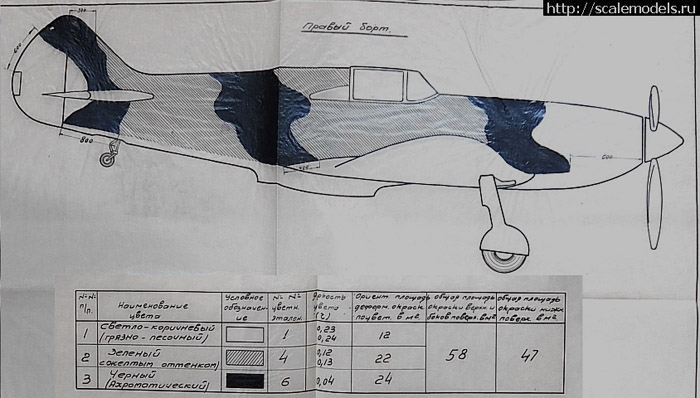
The old sketch aside was published by Mikhail Timin at http://scalemodels.ru/modules/forum/viewtopic.php?t=954&postdays=0&postorder=asc&start=620.
Probably it was from the original camouflaging guidelines, and shows three colors: light brown, green and black.
It is likely that the guidelines included the left and top views, but we haven't them.
The color of the undersurfaces is not written here, but the guidelines of May 1941 indicated light grey for the undersurfaces; the disposition of the red stars should be as for prewar standard: fuselage sides, under and uppersurfaces of each wing.
The painting of the frames and prop blades is not known.
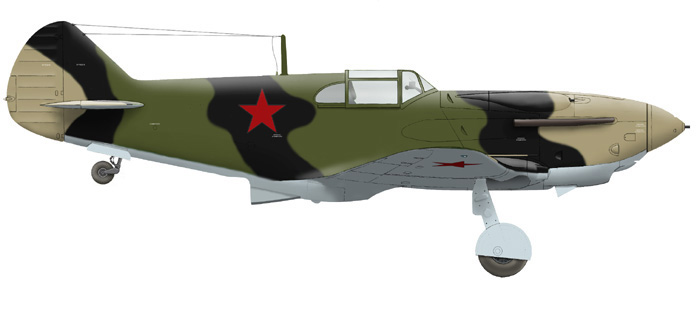
Here is a reconstruction of the look of this plane, excluding the dubious repaintings visible on the photos of the wreck.
The small stars is drawn in high position on the fuselage as it appears on a photo. The national stars probably were in six positions.
The lower surfaces were probably painted in AII light grey, gloss as all the camo colors.
All the details are likely as plane 273130.
s/n 3121321
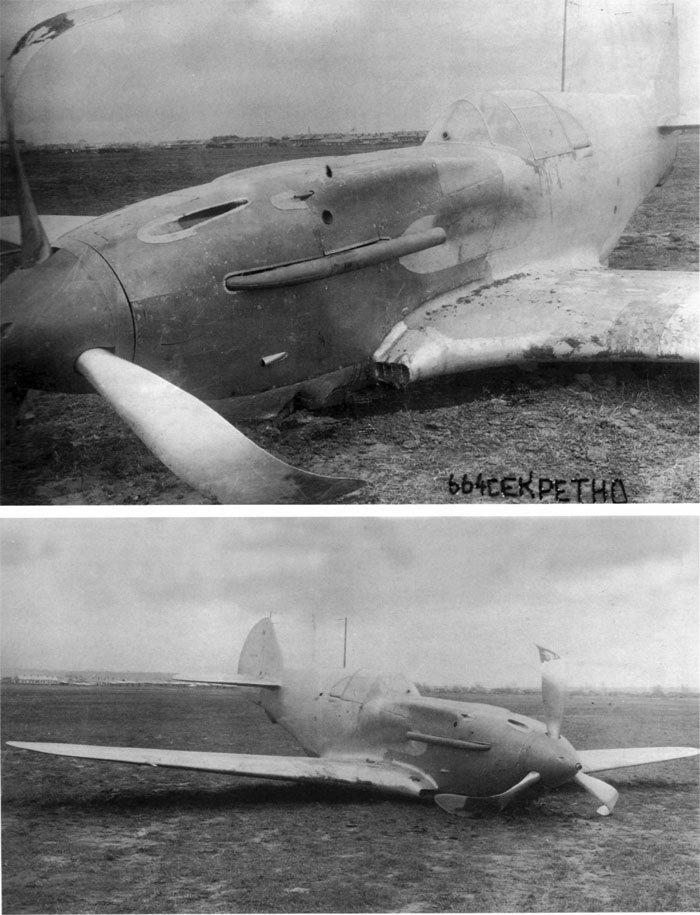
Two images of the wheel-up landing of LaGG-3 s/n 3121321, produced in Z.21, 3rd series. The plane, flown by A,G.Vishenkov, made a wheels-up landing on May 21, 1941.
The lack of a military livery and markings is noticeable. The plane is probably wearing a silver grey finish on wood/fabric surfaces (but yellow putty finish can't be excluded); the nose is painted with red-brown primer 138A, with some details left unpainted; the area around the air intakes seems painted with shiny aluminum paint.
The loss of aluminum paint on the bended prop blades is noticeable, and let see what is probably the underlying red brown primer.
Other characteristics of this plane are:
- predisposed for 5 guns : 3 UB 12 and 2 ShKAS;
- the coverings of the muzzles of the synchronized UB on the nose are not installed;
- there is an unique hole for waste shells expulsion on each side; it's unclear if the synchronized UB were really installed;
- no balance weights on the rudder;
- retractable tail wheel;
- rectangular wing root intakes;
- sharp-pointed steel plate behind the one-piece exhaust pipes;
- tall radio mast on the fuselage, with an unusual small radio mast on the top of the fin
- no slats.
s/n 3121565
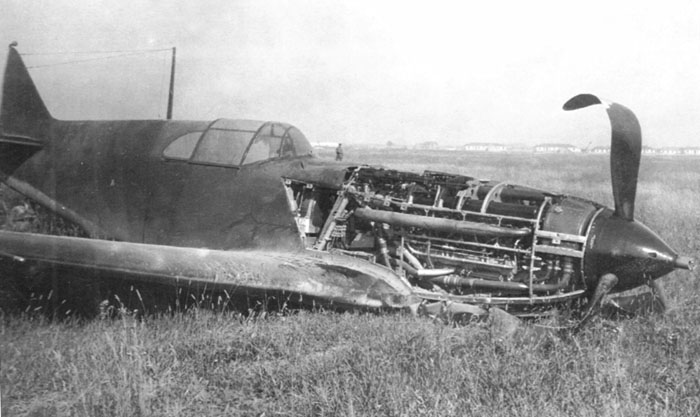
LaGG-3 s/n 3121565 (5th series of z.21) flown by G.M. Ivanov, made an emergency landing on May 21, 1941.
Apart for details related to the series, as the high mast, the fixed tail wheel and the balance horns on the rudder, we can guess something of the painting of this plane, that seems (badly) painted with non-homogeneous green upper and side surfaces. Noteworthy are the darker rear fuselage and right wing tip; though, it doesn't seem camouflaged, nor a classic prewar AII green/blue plane. Spinner and prop blades seem painted in glossy black.
The photo has to be retouched on the rear fuselage, because we see only fragments of the star that should be there.
Photo from Wydawnictwo Militaria 249 - LaGG-3
Plant n.23 in Leningrad was the first to complete a production LaGG-3, that was first flown by A. Nikashin in December 1940.
After remedying many defects in the cooling and control systems, the planes built here were delivered to 19 IAP at Gorelovo and 157 IAP near Leningrad.
The plant of Leningrad built only 65 planes, then the German advance towards the city led to an hurrily transfer to Novosibirsk, where the production of this type was not resumed.
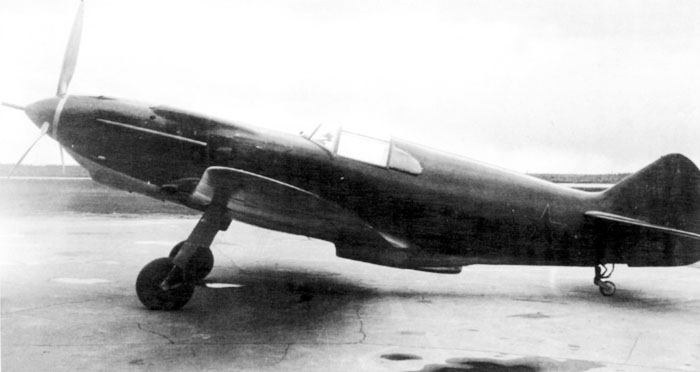
We haven't not photos of LaGG-3s built in Z.23 after the war. We can make an idea on how they could have appeared observing this plane, utilized as test bed for the installation of a Boris Shpitalnyy's 37 mm Sh-37 gun. The planes were named K-37 and quickly sent to the front.
The photo seems to show a typical prewar glossy AII green/blue livery, stars with thin silver outline on the prewar positions (fuselage, upper and lowe surface of the wings).
The plane had a small type, rubberized, retractable tail wheel, no radio mast or balance horns.
The omission of part of the main landing gear door, and perhaps of the tail wheel doors, could be a measure to spare weight after the installation of the big gun.
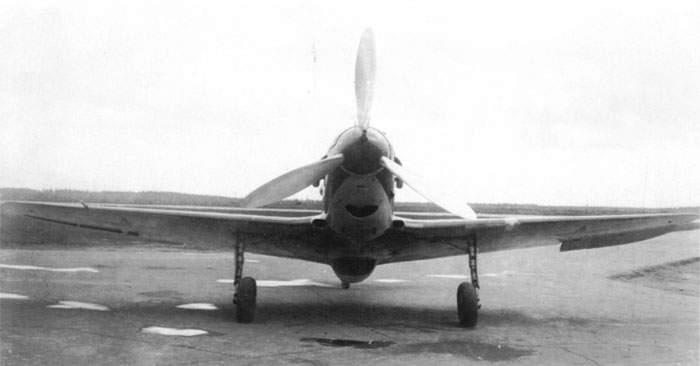
Another image of the same plane.
Both photos from Wydawnictwo Militaria 249 - LaGG-3
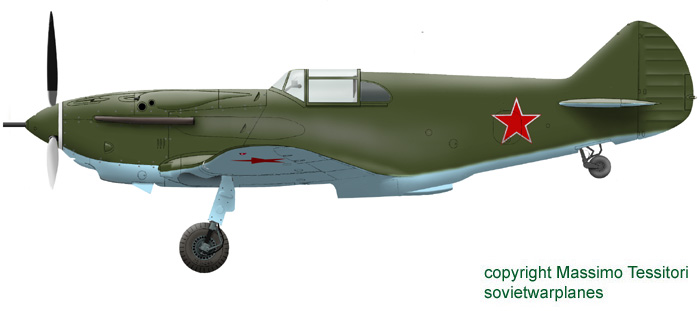
Zavod 31
Plant 31, then located in Taganrog, started to produce LaGG-3s under the supervision of Vladimir Gorbunov; he dealed with the scarcity of raw materials and equipment.
The first plane was delivered in March 1941, but the production's start was slow and the tempo of one machine per day was reached in May only; later, in August 1941, the factory output reached 130 planes for month.
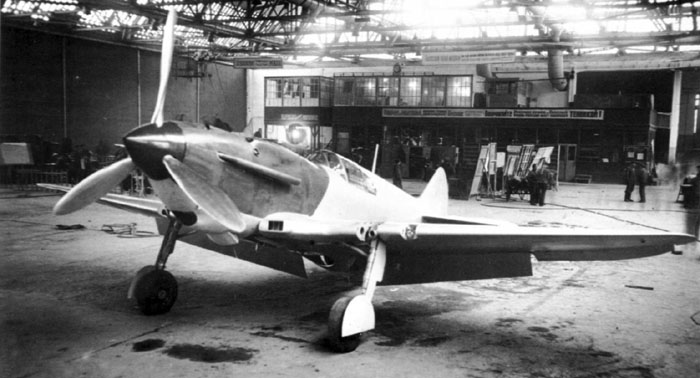
The first plane, not yet completed, built in Zavod 31 (s/n 27311?) was photographed in the factory in Taganrog on 10 February 1941.
At this stage, it's likely that the dominant colors were the yellowish putty on the wooden parts and the zinc chromate yellow ALG-1 on the metallic parts; the cowling (upper and side panels) and the propeller look unpainted aluminum, while the spinner could be painted with red-brown primer.
Photo from Wydawnictwo Militaria 249 - LaGG-3
s/n 273130
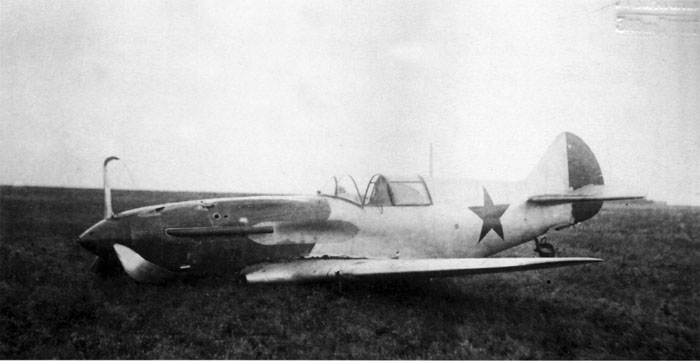
Plane s/n 273130, built in Z.31, made a wheels-up landing on May 27, 1941, while flown by V.N. Kusyeyev.
The plane is noticeable because of the lack of a full military livery; the apparent resemblance to s/n 3121321 (apart for the stars and red rudder) is noteworthy, although that plane was built by another factory.
Its wood/fabric surfaces appear in aluminum/grey dope (but yellowish putty can't be excluded); the nose, the canopy frames and the stabilizers appear in 138A red-brown primer, with some unpainted details; there are red stars on the fuselage sides (unclear if on the wings too) and the rudder looks painted red (apart for some parts around the hinges ), while elevators look silver. Some unpainted metal details are visible, including the sharp-ended steel plate behind the exhaust pipe; the area around the air intakes seems painted with shiny aluminum paint.
- predisposed for 5 guns : 3 UB 12 and 2 ShKAS;
- the coverings of the muzzles of the synchronized UB on the nose are not installed;
- two separate holes for the expulsion of the waste shells on each side (as expected);
- no balance weights on the rudder;
- retractable tail wheel;
- rectangular wing root intakes;
- sharp-pointed steel plate behind the one-piece exhaust pipes;
- short radio mast on the fuselage;
- no slats.
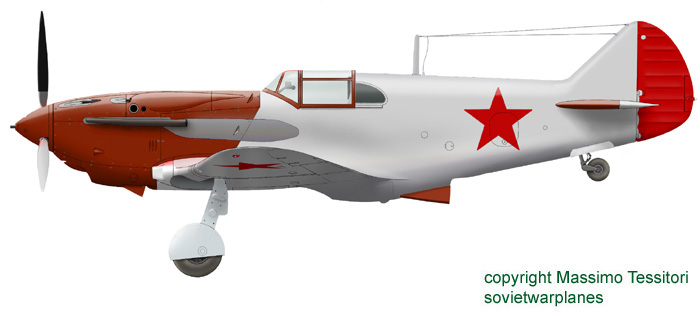
s/n 273159
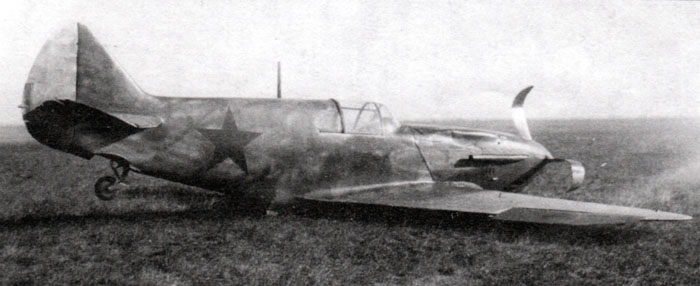
Aside:
plane s/n 273159, built in Zavod 31, flown by G.R. Rybyn, made a belly landing on Polyakovka airfield on July 9, 1941.
The painting of this plane is a weird mystery. It looks that it could have been delivered with a silver (or yellowish?) livery and red brown cowling panels, as s/n 273130, and that it was hurrily repainted with green and eventually other camo colors.
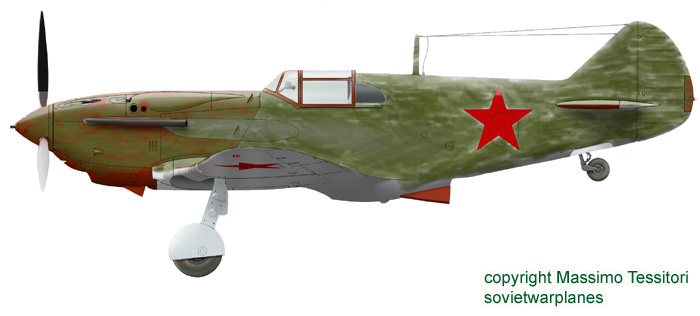
An attempt to represent this plane, supposing that its strange look was due to hurry and scarcity of paint.
If this has to be intended as an experimental camouflage, other colors could be overposed.
Plant n.153 in Novosibirsk, named after Valeriy P.Chkalow, started later
than other factories, and wasn't able to deliver any LaGG-3 within the
war's outbreak. Besides, when its deliveries started, the quality was
the worst between all the plants producing this type.

According to the captions, this plane should be of 11 GIAP in 1942, Leningrad area.
Nevertheless, its look suggests that it was a very early production plane of unidentified factory, still with the prewar livery.
The absence of red stars on the tail, the number on the rudder, the shining prop blades, the difference in shade between the metallic cowling panels and the rear of the fuselage suggest that this is a typical prewar AII green/light blue livery; the cowling and spinner turned to a lighter shade for effect of the sun, as observed on MiG-3s, and the front of the nose was retouched with new AII green paint.
Note the shining struts of the canopy and the mast. The air intakes and part of the leading edge is shining too; this resembles what was seen on some of the photos of the light-finished planes above.
The shape of the plate behind the exhaust stacks is unusual and inclined, ending close to the windshield.
Photo from Wydawnictwo Militaria 249 - LaGG-3
